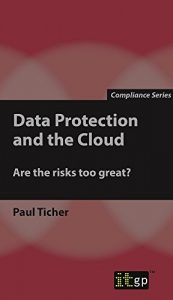Applying the Data Protection Act to the Cloud
The UK’s Data Protection Act 1998 (DPA) applies to the whole lifecycle of information, from its original collection to its final destruction. Failure to comply with the DPA’s eight principles could lead to claims for compensation from affected individuals and financial penalties of up to £500,000 from the Information Commissioner’s Office, not to mention negative publicity and reputational damage.
An expert introduction
More than 85% of businesses now take advantage of Cloud computing, but Cloud computing does not sit easily with the DPA. Data Protection and the Cloud addresses that issue, providing an expert introduction to the legal and practical data protection risks involved in using Cloud services.
Data Protection and the Cloud highlights the risks an organization’s use of the Cloud might generate, and offers the kind of remedial measures that might be taken to mitigate those risks.
Topics covered include:
•Protecting the confidentiality, integrity, and accessibility of personal data
•Data protection responsibilities
•The data controller/data processor relationship
•How to choose Cloud providers
•Cloud security – including two-factor authentication, data classification, and segmentation
•The increased vulnerability of data in transit
•The problem of BYOD (bring your own device)
•Data transfer abroad, US Safe Harbor, and EU legislation
•Relevant legislation, frameworks, and guidance, including: ◦the EU General Data Protection Regulation
◦Cloud computing standards
◦the international information security standard, ISO 27001
◦the UK Government’s Cyber Essentials scheme and security framework
◦CESG’s Cloud security management principles
◦guidance from the Information Commissioner’s Office and the Open Web Application Security Project (OWASP)
Mitigate the security risks
Mitigating security risks requires a range of combined measures to be used to provide end-to-end security. Moving to the Cloud does not solve security problems, it just adds another element that must be addressed. Data Protection and the Cloud provides information on how to do so while meeting the DPA’s eight principles.
About the author
With a background in IT focussed on CRM and other information management applications, Paul Ticher has worked on data protection for over 20 years. He is now a well-known consultant on the topic, mainly to non-profit organizations , and specialises in work with charities and voluntary organizations . Paul is the author of the standard work Data Protection for Voluntary Organisations (now in its third edition) as well as materials for ITGP and other publishers. He also carries out data protection reviews and delivers training and webinars on the topic.
The UK’s Data Protection Act 1998 (DPA) applies to the whole lifecycle of information, from its original collection to its final destruction. Failure to comply with the DPA’s eight principles could lead to claims for compensation from affected individuals and financial penalties of up to £500,000 from the Information Commissioner’s Office, not to mention negative publicity and reputational damage.
An expert introduction
More than 85% of businesses now take advantage of Cloud computing, but Cloud computing does not sit easily with the DPA. Data Protection and the Cloud addresses that issue, providing an expert introduction to the legal and practical data protection risks involved in using Cloud services.
Data Protection and the Cloud highlights the risks an organization’s use of the Cloud might generate, and offers the kind of remedial measures that might be taken to mitigate those risks.
Topics covered include:
•Protecting the confidentiality, integrity, and accessibility of personal data
•Data protection responsibilities
•The data controller/data processor relationship
•How to choose Cloud providers
•Cloud security – including two-factor authentication, data classification, and segmentation
•The increased vulnerability of data in transit
•The problem of BYOD (bring your own device)
•Data transfer abroad, US Safe Harbor, and EU legislation
•Relevant legislation, frameworks, and guidance, including: ◦the EU General Data Protection Regulation
◦Cloud computing standards
◦the international information security standard, ISO 27001
◦the UK Government’s Cyber Essentials scheme and security framework
◦CESG’s Cloud security management principles
◦guidance from the Information Commissioner’s Office and the Open Web Application Security Project (OWASP)
Mitigate the security risks
Mitigating security risks requires a range of combined measures to be used to provide end-to-end security. Moving to the Cloud does not solve security problems, it just adds another element that must be addressed. Data Protection and the Cloud provides information on how to do so while meeting the DPA’s eight principles.
About the author
With a background in IT focussed on CRM and other information management applications, Paul Ticher has worked on data protection for over 20 years. He is now a well-known consultant on the topic, mainly to non-profit organizations , and specialises in work with charities and voluntary organizations . Paul is the author of the standard work Data Protection for Voluntary Organisations (now in its third edition) as well as materials for ITGP and other publishers. He also carries out data protection reviews and delivers training and webinars on the topic.






